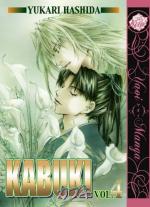|
This section contains 5,592 words (approx. 19 pages at 300 words per page) |

|
SOURCE: Kominz, Laurence. “Origins of Kabuki Acting in Medieval Japanese Drama.” Asian Theatre Journal 5, No. 2 (Fall, 1988): 132-45.
In the following essay, Kominz maintains that the impulse toward Kabuki drama began as early as the 1400s, and that Kabuki elements such as the role types aragoto (violent superhero) and wagoto (sensitive lover) are anticipated in such medieval plays as Soga Slices the Chest and Wada's Saké Party.
Much of the appeal of Japan's kabuki theatre lies in its vivid contrasts and startling juxtapositions: the stylized sets, like woodblock prints, peopled by human actors who often move like puppets; the unsurpassable grace and femininity of the female impersonators; the wicked samurai, noble outlaws, and virtuous prostitutes who turn the social order upside down. Of kabuki's contrasts none has been as consistently popular as the combination in a single play of two totally different male characters, the violent superhero and...
|
This section contains 5,592 words (approx. 19 pages at 300 words per page) |

|


